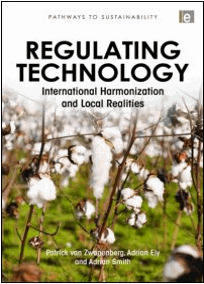 Book reviews
Book reviews-
Regulating Technology: International Harmonization and Local Realities Metabolism
Publishers
: Earthscan/ Routledge, London
Authors
: Patrick van Zwanenberg, Adrian Ely and Adrian Smith
Title
: Regulating Technology: International Harmonization and Local Realities Metabolism
Year of Publication
: 2011
Pages
: 150
ISBN
: 9781849712477
Reviewer
: Krishna B. Misra
Status
: Review Completed
The book consists of 8 chapters followed by preliminaries as given below:
List of Tables and Boxes
1 Page
Acknowledgements
1 Page
List of Abbreviations and Acronyms
2 Pages
Chapter 1
Introduction
7 Pages
Chapter 2
Framing Regulations
21 Pages
Chapter 3
Harmonizing Regulation
21 Pages
Chapter 4
National Frameworks for Regulating Transgenic Cotton
21 Pages
Chapter 5
Local Realities for Transgenic Cotton
26 Pages
Chapter 6
National Frameworks for Regulating Antibiotics
14 Pages
Chapter 7
Local Realities for Antibiotics
16 Pages
Chapter 8
Rethinking Regulation
14 Pages
Index
7 Pages
Technology has affected all facets of human activities but we must realize that no technology is without any risk to humans and environment that we live in. As the title of the book suggests, it is about regulating technology across different local settings within the interdependence and globalization of nations of the world.
 This book is a part of a book series that addresses core challenges around linking science and technology and environmental sustainability with poverty reduction and social justice. Citing two examples, the book investigates aspects of technology use that operates beyond the purview of negotiations of international regulators sitting in Geneva, Paris, Washington or Rome. The book claims that it is product of research project on Rethinking Regulation that was conducted during 2007 to 2010 and was led by Social, Technological and Environmental Pathways to Sustainability (STEPS) Centre of University of Sussex, which usually acts as a hub for wide range of international research projects.
This book is a part of a book series that addresses core challenges around linking science and technology and environmental sustainability with poverty reduction and social justice. Citing two examples, the book investigates aspects of technology use that operates beyond the purview of negotiations of international regulators sitting in Geneva, Paris, Washington or Rome. The book claims that it is product of research project on Rethinking Regulation that was conducted during 2007 to 2010 and was led by Social, Technological and Environmental Pathways to Sustainability (STEPS) Centre of University of Sussex, which usually acts as a hub for wide range of international research projects.The project comprised of two separate research teams for the projects conducted in Chaco province of Argentina and the other in Hubei province in China. The case studies selected in the book represent three important areas, viz, health, agriculture and water and demonstrates how important technologies impact on the welfare and sustainability in many ways and highlight the controversies surround regulation and use. In case of Chaco province in Argentina, the cotton produced there is mostly genetically modified and uses new insect resistant and herbicide tolerant seeds. However, with no cash and credit access to poor farmers, copied versions of the new varieties from local cooperatives and other sources. Therefore poor farmers are not getting the benefit of new technology and incur certain kind of risks as the levels of insecticidal toxin in the copied versions being low and sometimes without biosafety approval. In case of Hubei province in China, which has a booming pharmaceutical industry, the book highlights that risk to human health is high as people have access to wide range of drugs and if someone falls ill he/she is prescribed newer version of antibiotics even for common ailments. The book therefore emphasizes that there is urgent need to harmonize regulatory policies across the world which sometimes is at odds with the increasingly diverse local settings in which they are implemented.
This review has been published in IJPE volume 10|No6, 2014

